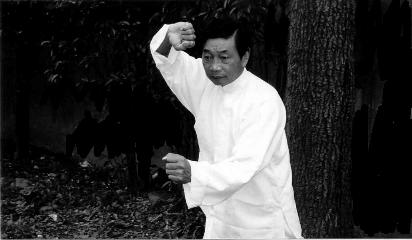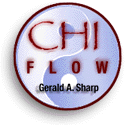Wu Style T'ai Chi Ch'uan
(Shanghai Branch) - Wu Chian Chuan Society (Ma Yueh Liang & Wu Ying Hua system)
Brief Biography of Teacher & Coach
Zhou Zang Fang
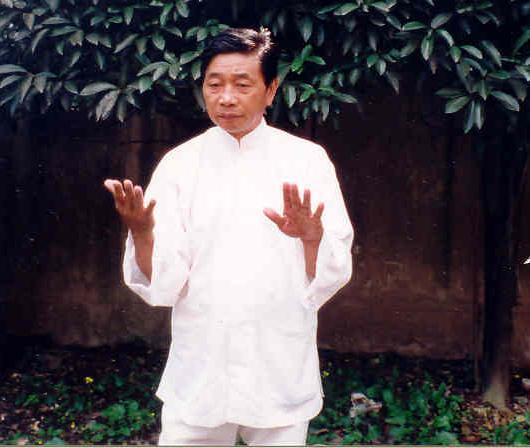
When Zhou Zhan Fang first started his martial arts training at the Jin Wu Athletic Federation of Shanghai in 1966 he made observed an interesting about the process people used in attacking and defending. Paradoxically, at certain times people appeared to be attacking they were actually defending, and while they appeared to be defending they really were attacking. Little did he know at the time that the observation he was making would be one of the keys that would unlock many of the mysteries of Tai Chi Chuan practice.
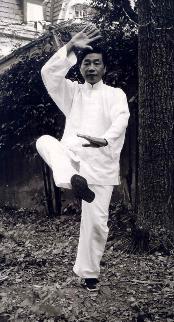 In 1980, Zhou Zhan Fang started his practice of Wu style Taijiquan under Ma Jiang Bao, son of Ma Yueh Liang. (Ma Jiang Bao now teaches in europe.) From this practice of the slow set and the push hands, Zhou Zhan Fang started to believe in the positive effects of T'ai Chi. While he felt it was a soft and yielding martial art, he observed that it was sharp and precise. He likened it to water cutting iron. He observed how softness was able to defend against strength or hardness, and how smoothness and calmness were effective in attacking. He recalled that in his practice of the external martial arts at Jin Wu that the emphasis was on speed, but in Wu style T'ai Chi Ch'uan, he felt that the emphasis was on smoothness, slowness, and calmness.
In 1980, Zhou Zhan Fang started his practice of Wu style Taijiquan under Ma Jiang Bao, son of Ma Yueh Liang. (Ma Jiang Bao now teaches in europe.) From this practice of the slow set and the push hands, Zhou Zhan Fang started to believe in the positive effects of T'ai Chi. While he felt it was a soft and yielding martial art, he observed that it was sharp and precise. He likened it to water cutting iron. He observed how softness was able to defend against strength or hardness, and how smoothness and calmness were effective in attacking. He recalled that in his practice of the external martial arts at Jin Wu that the emphasis was on speed, but in Wu style T'ai Chi Ch'uan, he felt that the emphasis was on smoothness, slowness, and calmness.
Zhou recalls he was quick to understand that the smooth, relaxed quality he was feeling and observing was not a lax, nonchalant and unfocused dance. Instead, the movements are cat-like, extremely focused and alert to change. In this way, Zhou feels you can understand how to apply self defense principles in T'ai Chi practice.
"When the opponent doesn't move, you don’t move. When the opponent moves you have to move before them." This is where the Yi (mind) needs to be focused and alert otherwise you don't "catch" what the opponent is doing. In 1985, Ma Jiang Bao introduced Zhou to Ma Yueh Liang and Wu Ying Hua Zhou was amazed with Ma's power for a man in his eighties and then on in to his nineties. Zhou recalls Ma discussing with him about the importance of being smooth and calm despite the environment or any type of attack. To learn T'ai Chi Ch'uan you need to follow the methods of T'ai Chi Ch'uan. Zhou heard Ma's words but at that time wasn't able to implement the concept completely. All Zhou does remember at that time is that Ma was very smooth, and what he was doing appeared to be concealed from Hocus understanding.
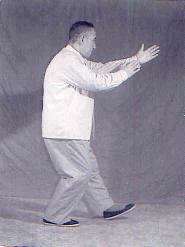 As time went by, Ma revealed to Zhou that the methods of T'ai Chi were as follows:
As time went by, Ma revealed to Zhou that the methods of T'ai Chi were as follows:
1) Overcome hardness with softness. This didn't mean that you overcome only the opponent. This also means to conquer yourself: discovering your own softness; and concealing your strength; learning to control your softness and harness it. Ma related to Zhou that this means to at times be like a cottony cloud, so puffy and soft, and yet inside you are like steel that cannot be detected or seen.
2) Meet the offensive with calmness. Zhou relates that Ma meant that to meet (or neutralize) softness could not be accomplished without employing Ting Jing (Listening Energy).
3) Victory belongs to the opponent with lesser strength but better skill. The skill that's the most important, according to Zhou is balance. When you watch a practitioner, you need to concentrate on the Yin and Yang of their balance. In Push Hands, if the balance is not exact you will see very quickly whether their skill is better than their strength.
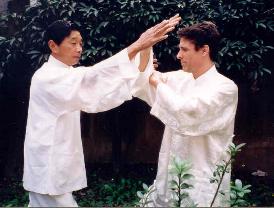 A large part of the legacy of Ma Yueh Liang and Wu Ying Hua can be found in the students that they taught. Many of these students are now teaching themselves, and in some cases there are several generations of students that are now teaching. Some of the most senior of these students hold leadership positions in the Wu style Taijiquan "Chian Chuan Society" of Shanghai, where Zhou Zhan Fang is a coach. Zhou Zhan Fang is included in family picture in the front of Ma Yueh Liang's Wu style Taijiquan Sword book. Zhou Zhan Fang's formal "disciple" picture with Ma and Wu appears in Power Push Hands instructional video. There may be more video of Ma Yueh Liang publicly pushing hands with Zhou Zhan Fang than with any of his other students.
A large part of the legacy of Ma Yueh Liang and Wu Ying Hua can be found in the students that they taught. Many of these students are now teaching themselves, and in some cases there are several generations of students that are now teaching. Some of the most senior of these students hold leadership positions in the Wu style Taijiquan "Chian Chuan Society" of Shanghai, where Zhou Zhan Fang is a coach. Zhou Zhan Fang is included in family picture in the front of Ma Yueh Liang's Wu style Taijiquan Sword book. Zhou Zhan Fang's formal "disciple" picture with Ma and Wu appears in Power Push Hands instructional video. There may be more video of Ma Yueh Liang publicly pushing hands with Zhou Zhan Fang than with any of his other students.
Zhou lives in Shanghai with his wife who is skilled in the art of Shan Sui Hua, a style of brush work that combines calligraphy with color . Their son is a college student in Switzerland and practices the Wu Simplified form, sword, and push hands. Zhou Zhan Fang is featured in the Wu Style Taijiquan Power Push Hands set of instructional videos and we hope he will have many other collaborations with the chiflow.com group. Teacher Zhou Zhan Fang can be contacted either through the chiflow website or through the Chian Chuan Taichichuan Society in Shanghai.
